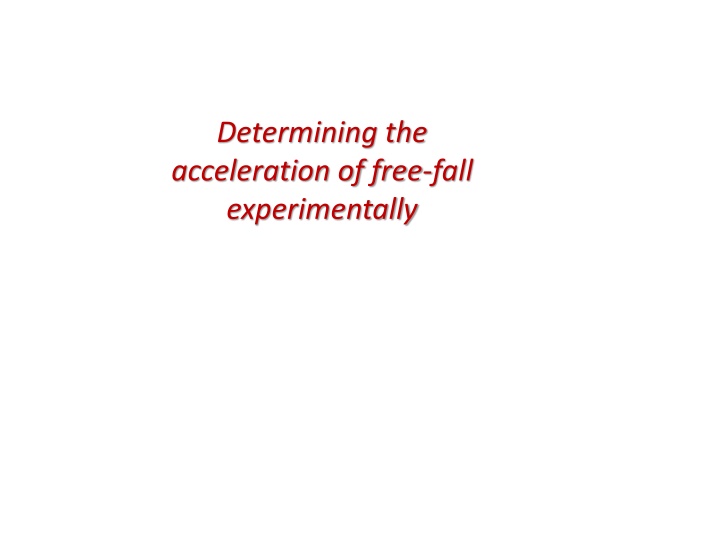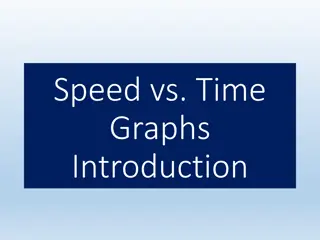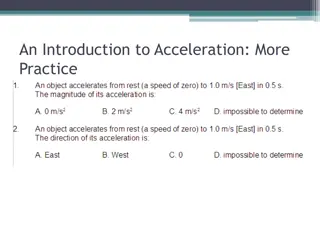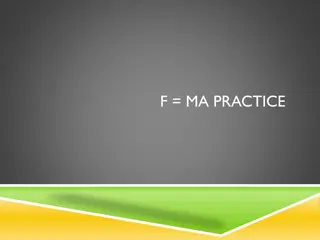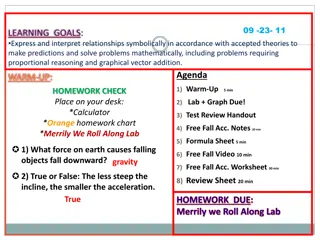Experimental Determination of Acceleration of Free Fall
Experimentally determining the acceleration of free fall by analyzing the motion of an apple and a feather falling in a vacuum. By scaling and analyzing the data, the acceleration is calculated to be approximately 9.82 m/s^2, indicating a constant acceleration due to gravity.
Download Presentation

Please find below an Image/Link to download the presentation.
The content on the website is provided AS IS for your information and personal use only. It may not be sold, licensed, or shared on other websites without obtaining consent from the author.If you encounter any issues during the download, it is possible that the publisher has removed the file from their server.
You are allowed to download the files provided on this website for personal or commercial use, subject to the condition that they are used lawfully. All files are the property of their respective owners.
The content on the website is provided AS IS for your information and personal use only. It may not be sold, licensed, or shared on other websites without obtaining consent from the author.
E N D
Presentation Transcript
Determining the acceleration of free-fall experimentally
Determining the acceleration of free-fall experimentally Consider the multiflash image of an apple and a feather falling in a vacuum: If we choose a convenient spot on the apple, and mark its position, we get a series of marks like so:
Determining the acceleration of free-fall experimentally Now we SCALE our data. Given that the apple is 8 cm in horizontal diameter we can superimpose this scale on our photograph. 0 cm Then we can estimate the position in cm of each image. -9 cm -22 cm -37 cm -55 cm
Determining the acceleration of free-fall experimentally Suppose we know that the time between images is 0.056 s. 0 cm We make a table starting with the raw data columns of t and y. -9 cm We then make calculations columns in t, y and v (processed data). -22 cm y y t t t(s) t(s) y(cm) y(cm) v v .000 .000 0 0 .056 To find t you need to subtract TWO t's. Therefore the first entry for t is BLANK. To find t you need to subtract TWO t's. CURRENT t MINUS PREVIOUS t. CURRENT y MINUS PREVIOUS y. -37 .168 -37 cm -9 -9 -161 -161 -9 -9 .056 .056 .056 To find y you need to subtract TWO y's. To find v you need to divide y by t. .112 .112 Same thing for the first y. Since v = y / t, the first v entry is also BLANK. -22 -22 .056 .056 -13 -13 -232 -232 .168 -37 .056 .056 -15 -15 -268 -268 .224 .224 -55 -55 .056 .056 -55 cm -18 -18 -321 -321
Determining the acceleration of free-fall experimentally t y Now we plot vvs. t on a graph t(s) y(cm) v .000 0 -161 .056 -9 .056 -9 .112 -22 .056 -13 -232 .168 -37 .056 -15 -268 v .224 -55 .056 -18 -321 TIME / sec .112 .224 .000 .056 .168 VELOCITY / cm sec-1 0 t -50 -100 -150 -200 -250 -300
Determining the acceleration of free-fall experimentally v TIME (sec) .224 .000 .056 .112 .168 0 t / s VELOCITY (cm/sec) t = 0.224 s -50 -100 -150 -200 -250 -300 v = -220 cm/s Finally, the acceleration is the slope of the vvs. t graph: ? = ? ?= 220 ??/? 0.224? = 982?? ?2= 9.82 ?/?2 The graph v vs. t is linear. Thus a is constant. The y-intercept (the initial velocity of the apple) is not zero. But this just means we don t have all of the images of the apple
Graphs of free fall motion u = 0 m/s x= 5 t2 v= 10t time speed distance (s) (m/s) 0 0 (m) 0 1 10 5 2 20 20 3 4 30 40 45 80 Velocity vs. time Distance vs. time 40 80 velocity (m/s) Distance (m) 30 60 40 20 10 20 0 0 1 2 3 4 5 0 1 2 3 4 5 Time (s) Time (s) constant slope constant acceleration changing slope changing speed acceleration
Qualitatively describing the effect of fluid resistance on falling objects or projectiles, including reaching terminal speed -Students should know what is meant by terminal speed. -This is when the drag force exactly balances the weight
"A female Blue Whale weighing 190 metric tonnes (418,877lb) and measuring 27.6m (90ft 5in) in length suddenly materialized above the Southern Ocean on 20 March 1947." y At first, v = 0. Guinness World Records. Falkland Islands Philatelic Bureau. 2 March 2002. W Suppose a blue whale suddenly materializes high above the ground. Then, as v increases, so does D. y D The drag force D is proportional to the speed squared for high speeds. For low speeds it is proportional to speed. W Thus, as the whale picks up speed, the drag force increases v v reaches a maximum value, called terminal speed. Once the drag force equals the whale s weight, the whale will stop accelerating. D D = W. It has reached terminal speed. W vterminal
If air resistance can not be neglected, there is additional force (drag force) acting on the body in the direction opposite to velocity.
Comparison of free fall with no air resistance and with air resistance In vacuum In air terminal velocity is maximum velocity an object can reach in air/any fluid. displacement displacement Acceleration is getting smaller due to air resistance and eventually becomes zero. time time When the force of the air resistance equals gravity, the object will stop accelerating and maintain the same speed. velocity velocity time time It is different for different bodies. acceleration acceleration time time
Comparison of free fall with no air resistance and with air resistance In vacuum In air terminal velocity is maximum velocity an object can reach in air/any fluid. displacement displacement Acceleration is getting smaller due to air resistance and eventually becomes zero. time time When the force of the air resistance equals gravity, the object will stop accelerating and maintain the same speed. velocity velocity time time It is different for different bodies. acceleration acceleration time time
Air drag and terminal speed If a raindrops start in a cloud at a height h = 1200m above the surface of the earth they hit us at 340mi/h; serious damage would result if they did. Luckily: there is an air resistance preventing the raindrops from accelerating beyond certain speed called terminal speed . How fast is a raindrop traveling when it hits the ground? It travels at 7m/s (17 mi/h) after falling approximately only 6 m. This is a much kinder and gentler speed and is far less damaging than the 340mi/h calculated without drag. The terminal speed for a skydiver is about 60 m/s (pretty terminal if you hit the deck)
